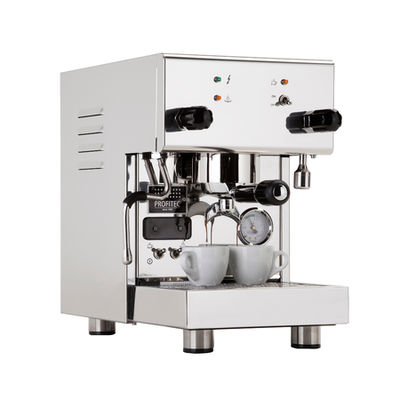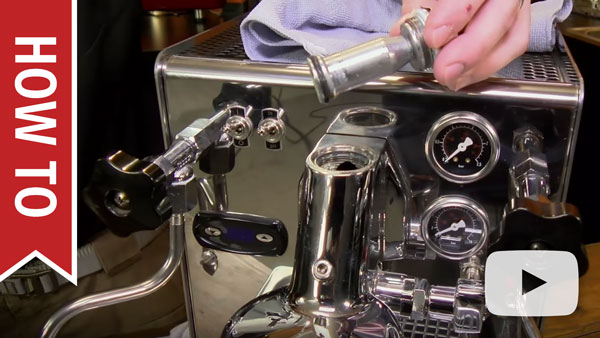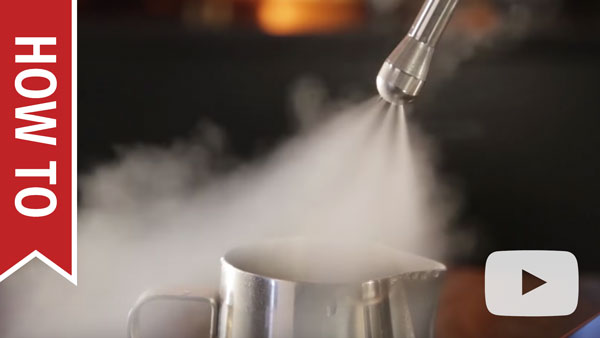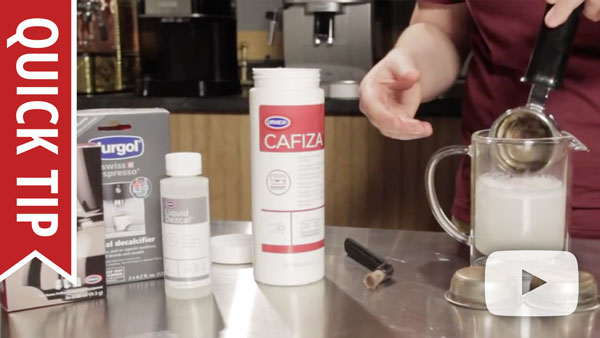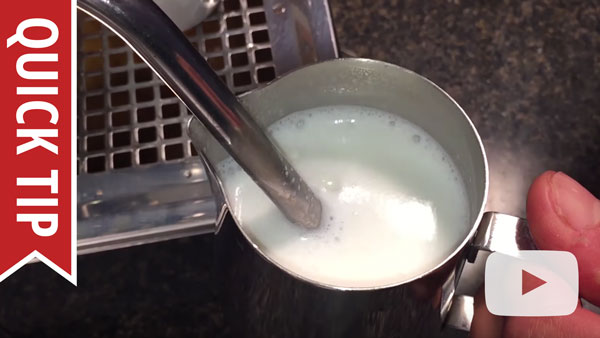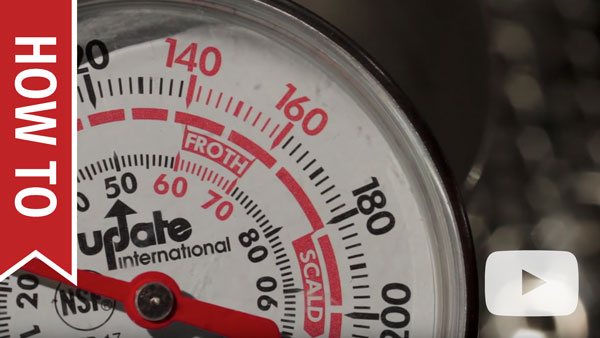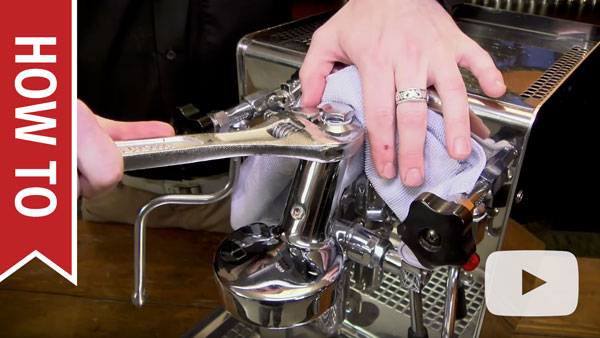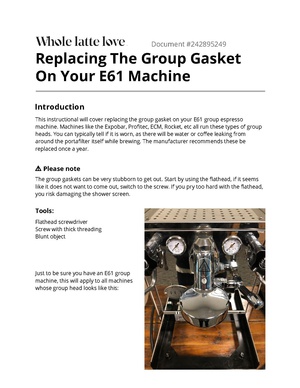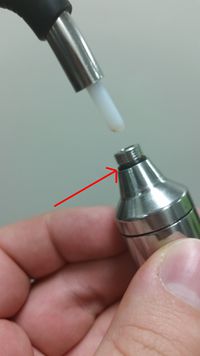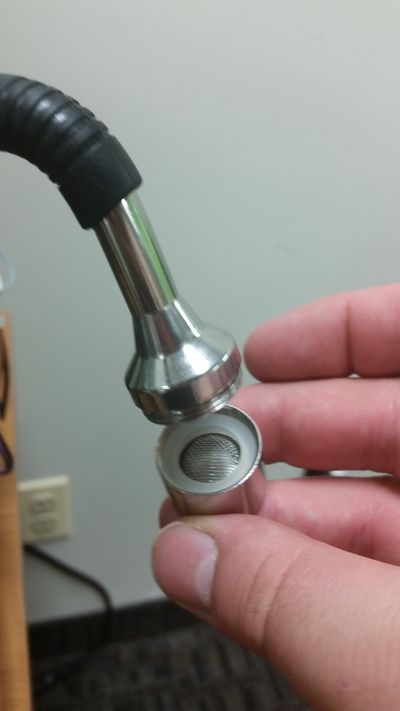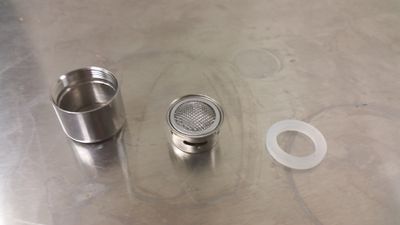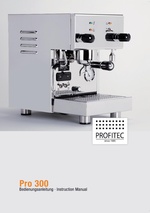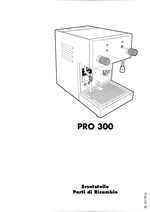Profitec Pro 300
From Whole Latte Love Support Library
The Profitec Pro 300 is a Prosumer espresso machine that features a commercial dual boiler system in a compact home machine.
| Profitec Pro 300 |
|---|
| Manufacturer: Profitec |
| Model Name: Pro 300 |
| Type: Prosumer |
Basic Usage
Getting Started
Adjusting The PID
The Pro 300 uses a Gicar PID, utilized by other Profitec machines. The video below shows how to program the PID on a Pro 700. The procedure is the same for the 300 machine.
Reading The Brew Gauge
The brew pressure gauge is only meaningful when the machine is actively brewing. While the machine is standing by the gauge may move around, sit at zero, or show the the circuit is pressurized; this does not mean anything. This gauge is only accurate while the brew circuit is activated during brewing. A simple test of the machine's brew pressure can be completed by using the backflush disc.
- Insert the backflush disc into the portafilter and attach it to the machine.
- Activate the brew function. The gauge will fall to zero, and then begin pressurizing.
- After about 10-15 seconds the pressure should read 8-11 Bar pressure. If your machine does this then there is nothing wrong with the brew function or brew gauge, the machine is operating to spec.
Cleaning & Maintenance
Proper machine maintenance is critical for machine function. Most machine failures are caused by lack of cleaning and many manufacturer warranties do not cover cleaning related breakdowns, so it is important to keep a regular maintenance schedule. Listed below is a suggested maintenance schedule for most Prosumer espresso machines:
Descaling
Grouphead Cleaning
The grouphead should be taken apart on a monthly basis to remove scale buildup, remove coffee residues, and improve shot flavor.
Steam Wand Cleaning
The steam wand should be cleaned daily once the machine is finished for the day. Milk residues quickly build up on the steam wand, so it's important to keep it clean to prevent blockages from forming.
Recommended Cleaning Products
The best product for backflushing, cleaning grouphead components, and cleaning filter baskets is a backflushing powder like Urnex Cafiza.
Troubleshooting
No Crema or Bad Tasting Shots
Typically, issues with crema or the flavor of the shot do not indicate a malfunction of the machine. Instead, this indicates that an adjustment needs to be made in the brewing process or that different beans need to be used.
The following articles review the different variables and offer solutions:
- Tamping The Correct Way and The Effects Of Tamping Pressure
- Grinding Coffee For Espresso
- It is important to use fresh beans, typically beans roasted within the past two weeks are best. Light and medium roasts are best for espresso brewing and richer crema. Storing beans properly is also important, more information can be found here.
If the behavior persists after reviewing these factors then the machine may need to be cleaned. Lack of cleaning can cause burned or bitter flavors, or create flow issues which can result in a weak shot. Navigate to the Cleaning & Maintenance icon above for more information.
Difficulty Frothing
As with brewing, technique is critical to frothing well. Frothing is very sensitive to technique, which has a steep learning curve. If the machine is producing steam then an adjustment to technique may need to be made. The video on the right shows proper frothing technique.
Many frothing mistakes are common missteps that result in poor or no froth. The video on the right identifies these mistakes and shows how to correct them.
It is also important not to overheat your milk. The milk will have the sweetest and most velvety texture between 140-150 F°. As you froth past this point the milk will lose its sweetness, the froth will take on a gummier texture, and eventually the milk will scald and begin to taste burnt. The video on the right explains how to use a frothing thermometer so that the milk is kept within the ideal range.
Flow Issues
The first place to start with any flow issue is cleaning the machine. Before going through these steps please make sure the machine is cleaned according to the Cleaning & Maintenance section of this article.
No Steam From Wand
- Check the brew function on the machine and see if water is able to flow through the machine for this function.
- If the brew water is not flowing either refer to the No Flow At All section of this article
- If the brew water flows but is not hot refer to the On But Not Heating section of this article.
- Check the hot water function of the machine. If you are able to draw hot water then the steam boiler must be pressurizing and heating, because hot water is expelled from the machine by steam pressure.
- Check the steam gauge of the machine. Does it show pressure? Typical range for the steam gauge should be 1-1.2 Bar.
- If the gauge is within the 1-1.2 Bar range then the steam wand is likely blocked.
- Remove the tip from the steam wand and test the flow. If flow is restored then the tip needs to be cleaned and reattached.
- If the flow is still blocked then there may be a blockage in the steam wand itself. Clean the wand by using a pipe brush that has synthetic or plastic bristles; metal bristles can damage the wand. Then soak the wand in a solution of hot water and backflushing powder for ten minutes. Test flow again.
- If there still isn't flow then there may be a blockage farther back in the steam circuit. The machine may need to be professionally cleaned to remove the blockage.
- If the gauge is not reaching 1-1.2 Bar, but it is pressurizing some, then the steam pressurestat may just need to be adjusted.
- When adjusting the pressurestat only slight adjustments should be made. Small adjustments will make a large difference in the pressure.
- Unplug the machine and remove the cover.
- Once the cover is removed the pressurestat can be found on the right hand side of the machine.
- Use a flathead screwdriver to make an adjustment to the pressure. Only make a 1/4 turn adjustment, as a small adjustment can make a significant change in the steam pressure. To raise the pressure turn clockwise; to lower the pressure turn counterclockwise.
- If adjusting the pressurestat the first time did not raise the pressure try adjusting it a few more times. If the pressure is still not raising after several adjustments then the pressurestat is likely broken and will need to be replaced.
- When adjusting the pressurestat only slight adjustments should be made. Small adjustments will make a large difference in the pressure.
- If the gauge sometimes reaches 1-1.2 Bar, but flicks around a lot or randomly drops to zero, or is always sitting at zero then the steam boiler is not building pressure for some reason.
- The high limit switches may be tripped. The high limit switch is an internal killswitch which prevents damage to the machine caused by power surges or the machine overheating. Resetting the high limit switches is simple. In the center of each switch is a small black button that you will need to press a few times to reset the switch. The high limit switches are listed as part 2 on p.8 of the machine's parts diagram.
- While the machine is open for resetting the high limit switch, check to make sure the wiring to the pressurestat isn't loose or disconnected. Reconnect the wires and see if the steam circuit pressurizes properly.
- If there weren't any disconnected wires then the pressurestat will need to be replaced.
- If the gauge is within the 1-1.2 Bar range then the steam wand is likely blocked.
Poor Or No Flow From Grouphead
If the steam/hot water for the machine is working fine then there is likely something causing a blockage or pressure issue in the brew circuit. Otherwise refer to the section of this article that discusses the machine not flowing at all.
- If a water softener is attached to the inlet line of the machine, it may be preventing water from flowing. Please remove the softener and see if the flow improves.
- The grouphead is dirty and needs to be cleaned.
- Taking apart the grouphead for manual cleaning is the first step. This should be done on a monthly basis. The instructions can be found here.
- If cleaning the grouphead restores flow to the grouphead, the machine should be immediately backflushed to prevent further flow issues.
Maintaining Your Espresso Machine - Backflushing
- There might be a kinked, broken, or loose line somewhere in the machine. Remove the top of the machine and take a look inside to see if you see any obvious issues.
- There might be an issue with one of the internal valve assemblies, which may need to be cleaned or replaced.
- Try adjusting the OPV to see if the brew pressure changes. Turn the machine off, and then remove the cover.
- The OPV will be located on the back left side of the machine; the adjustment screw will be facing straight upwards.
- To raise the pressure simply turn the screw on the OPV clockwise. Only have turn adjustments should be made at a time, as a half turn will result in a large pressure difference. Caution should be used to not raise the pressure too high, since this machine does not have a brew pressure gauge.
No Hot Water From Tap
- Check the brew function on the machine and see if water is able to flow through the machine for this function.
- If the brew water and steam are not flowing either refer to the No Flow At All section of this article
- If the brew water flows but is not hot refer to the On But Not Heating section of this article.
- Check the steam function of the machine. If you are able to draw steam form the steam wand then the steam boiler must be pressurizing and heating.
- Check the steam gauge of the machine. Does it show pressure? Typical range for the steam gauge should be 1-1.2 Bar.
- If the gauge is within the 1-1.2 Bar range then the hot water tap is likely blocked.
- Remove the tip from the hot water tap and test the flow. If flow is restored then the tip needs to be cleaned and reattached. Mineral deposits can easily collect in the screen/holes of the hot water tap, so be sure to clean these thoroughly. Soaking the tip in a solution of hot water and backflushing powder will help remove residues more effectively.
- If the flow is still blocked then there may be a blockage in the wand of the hot water tap. Clean the wand by using a pipe brush that has synthetic or plastic bristles; metal bristles can damage the wand. Then soak the wand in a solution of hot water and backflushing powder for ten minutes. Test flow again.
- If there still isn't flow then there may be a blockage farther back in the hot water circuit. The machine may need to be professionally cleaned to remove the blockage.
- If the gauge is not reaching 1-1.2 Bar, but it is pressurizing some, then the steam pressurestat may just need to be adjusted.
- When adjusting the pressurestat only slight adjustments should be made. Small adjustments will make a large difference in the pressure.
- Unplug the machine and remove the cover.
- Once the cover is removed the pressurestat can be found on the right hand side of the machine.
- Use a flathead screwdriver to make an adjustment to the pressure. Only make a 1/4 turn adjustment, as a small adjustment can make a significant change in the steam pressure. To raise the pressure turn clockwise; to lower the pressure turn counterclockwise.
- If adjusting the pressurestat the first time did not raise the pressure try adjusting it a few more times. If the pressure is still not raising after several adjustments then the pressurestat is likely broken and will need to be replaced.
- When adjusting the pressurestat only slight adjustments should be made. Small adjustments will make a large difference in the pressure.
- If the gauge sometimes reaches 1-1.2 Bar, but flicks around a lot or randomly drops to zero, or is always sitting at zero then the steam boiler is not building pressure for some reason.
- The high limit switches may be tripped. The high limit switch is an internal killswitch which prevents damage to the machine caused by power surges or the machine overheating. Resetting the high limit switches is simple. In the center of each switch is a small black button that you will need to press a few times to reset the switch. The high limit switches are listed as part 2 on p.8 of the machine's parts diagram.
- While the machine is open for resetting the high limit switch, check to make sure the wiring to the pressurestat isn't loose or disconnected. Reconnect the wires and see if the hot water circuit pressurizes properly.
- If there weren't any disconnected wires then the pressurestat will need to be replaced.
- If the gauge is within the 1-1.2 Bar range then the hot water tap is likely blocked.
No Flow At All
- If the pump does not sound like it is activating:
- Check to make sure the water tank is filled, and the machine isn't indicating that the water tank is empty.
- If the tank is empty, refill it.
- If the tank is full, but the machine thinks the water tank is empty, then the tank may not be seated correctly. Make sure there isn't anything blocking the tank from sitting flush inside the machine.
- Remove the cover of the machine, and check for any loose or disconnected wires.
- Make sure there aren't any kinked or pinched hoses.
- There may be an issue with the water tank sensor.
- Remove the drip tray from the front and make sure the plumb switch is turned off.
- Remove the reservoir and make sure the float magnet is facing the sensor. The magnet on the float should be facing the front left corner of the tank, where it meets up with the sensor.
- Check to make sure the wire for the water level sensor isn't loose/disconnected on the inside of the machine.
- There may be an issue with the pump powering on. Check to make sure the pump doesn't have any loose/disconnected wires.
- Check to make sure the water tank is filled, and the machine isn't indicating that the water tank is empty.
- If the pump does sound like it is activating:
- Check the water tank to make sure it is filled and that both the inlet line and the return lines are inserted into the tank. Make sure the inlet line in particular is below the surface of the water.
- If you are using the water softener on the inlet line, try removing it and see if water can flow through the machine.
- Open up the machine. Make sure there aren't any kinked or pinched hoses anywhere.
- There may be a stuck valve inside the machine.
Machine Is Leaking
Between Portafilter & Grouphead
If the machine is leaking from between the grouphead and the portafilter then the grouphead gasket is either pushed out of place and needs to be reinserted properly, or the gasket is worn out. Typically, grouphead gaskets will wear out in approximately 6 months to a year depending on how heavily the machine is used. Premature wear to this gasket can be caused by using excessive force when attaching the portafilter. It is important to distinguish where the leaking is occurring. If the leaking is originating from farther up on the grouphead assembly and then draining down to where the portafilter is attached, then refer to the section of this article which discusses leaking from the grouphead.
If the leaking is coming from between the portafilter and grouphead where you twist the handle on, then the gasket will need to be replaced. Instructions for replacing the group gasket can be found on pp.24-25 of the machine manual. You can try using the instructions to clean and reseat the current gasket. If that does not resolve the leak then the gasket will need to be replaced.
The gasket can get stuck in the grouphead from wear or excessive heat exposure. To remove the gasket take some self-tapping screws and partially screw them into the group gasket. Make sure not to go all the way through the gasket because you can scratch/dent the grouphead if you go too far. Then use a pair of pliers to pull on the screws and the gasket will pull out with them.
From Bottom Of Machine
- Check the water tank and drip tray to make sure there are no cracks or breaks where water can escape. Make sure they are properly positioned on the machine.
- Open the machine and check all of the connections to make sure they are securely attached.
- Examine the pump and boiler assemblies to see if there are any cracks in them. If the machine was exposed to subfreezing conditions without being properly drained it can cause these components to crack. These parts will need to be replaced if they are cracked.
- Make sure both the inlet line and the outlet line on the pump are securely connected.
- Check the various valves located on top of the boiler assembly.
- If water is leaking from the relief valves, then the boiler may be overfilling. Distilled, reverse osmosis, and zero water are not compatible with this style of machine as the water level probe depends on minerals in the water to detect its presence. These water types do not contain minerals, and so the machine will continuously fill until it overflows, usually resulting in water leaking from the relief valves.
- If water is leaking from the relief valves even though you are using a water that contains minerals, then you may need to clean the water level probe.
- If the valves are leaking directly from where they screw into the boiler, then they may have a broken seal. Try resealing the valves by using white teflon plumbers tape or food safe permabond and screwing them back into the boiler.
- If there are any broken or cracked hoses, or hoses with pinhole leaks, they will need to be replaced.
- If you cannot find the source of the leak, it's possible the water you are seeing is from water spilled when refilling the machine, or from the drip tray being out of position. It is also possible to run the unit with the casing off to help identify the source of the leak; precautions should be taken to protect yourself from any exposed wiring or hot water or steam that comes from the machine if you attempt this.
From Steam Wand Or Hot Water Tap
- If either wand is leaking from the end of the wand, it means the steam/hot water valve is not fully closed.
- Make sure the knob is securely in the closed position.
- If the knob feels loose, or doesn't appear to be properly engaging, then there may be a loose or broken part in the knob assembly.
- Slide the knob off. It will simply pull straight off.
- Once removed the shaft that the knob attaches to will be exposed. The shaft will have a D shape to it, and the back of the knob will have a corresponding D shaped hole on the back of it. Make sure this hold isn't broken or warped, causing the knob not to engage the shaft.
- If the knob appears to be in tact, then the valve may be stuck. Use a pair of pliers to directly turn the shaft to set the valve to the closed position. Put the knob back on and see if the valve opens and closes normally now.
- If the leaking persists, then the corresponding valve may need to be replaced.
- If the wand is leaking between the tip and the arm of the wand during use, there is an o-ring that is broken, missing, or out of position.
- The steam tip o-ring is easy to access. Simply unscrew the steam tip and there will be a small o-ring between the tip the wand arm. Inspect this o-ring for damage and clean it.
- The hot water tip is a little more complicated, but still easily accessed and cleaned.
- First unscrew the tip assembly from the wand arm.
- There will be an o-ring between the tip assembly and the wand arm. If the leaking was coming from here, then this o-ring needs to be cleaned and repositioned, or if it is damaged it will need to be replaced.
- If the leaking was coming from farther down on the tip, then the tip will need to be disassembled further to troubleshoot. To disassemble the tip further simply twist the two halves of the tip assembly in opposite directions. Alternatively you can screw the tip back onto the machine and then just unscrew the bottom half of the tip; this will give you a better grip on the tip to unscrew the two halves.
- Once the tip is apart it will separate into three separate pieces. There will be three metal pieces and another o-ring. Inspect the o-ring for cleanliness and damage. The metal pieces can be soaked in a solution of hot water and backflushing powder to remove any scale buildup on them.
- If the wand is leaking from the ball joint, then there may an o-ring that is worn out or out of position.
Machine Not Heating Or Powering On
No Power
- Make sure the machine is plugged into an appropriate power source.
- Do not use the machine on a surge protector. This machine has a high power draw, more than a typical kitchen appliance such as a refrigerator or a microwave. Surge protectors are typically not rated to handle the amperage this machine requires.
- Try using the machine on a different outlet, and make sure the machine is the only appliance plugged into that outlet.
- Make sure the power switches are functioning properly and not broken. If the machine isn't powering on try pressing and holding the power button in the on position to see if the machine turns on. If you are able to power the machine on this way then the power switch needs to be replaced.
- If the machine recently had a leak, had water spilled on it, or any other exposure to moisture then the machine may be shorting out. Try letting the machine sit unplugged for 48 hours to make sure there isn't a short caused by moisture.
Brew Not Heating
- Give the machine sufficient time to heat up. A heating time of 20-30 minutes is recommended for prosumer style machines for it to be sufficiently heated for brewing. Make sure the portafilter is attached during heating.
- Make sure the heating indicator is on. If the heating indicator is not on, then the machine will not heat. Typically this light will be off if the machine is out of water or not able to fill the boiler.
- Make sure the brew temperature is programmed to an acceptable temperature. Optimum temperature for brewing is between 195-205 F°. Make sure the PID is programmed to a temperature in this range. The Pro 300 uses a Gicar PID, utilized by other Profitec machines. The video below shows how to program the PID on a Pro 700. The procedure is the same for the 300 machine.
- The high limit switch may be tripped and needs to be reset. The high limit switch is an internal killswitch which prevents damage to the machine caused by power surges or the machine overheating. Resetting the high limit switches is simple. In the center of each switch is a small black button that you will need to press a few times to reset the switch. The high limit switches are listed as part 2 on p.8 of the machine's parts diagram.
- The heating element may be broken and may require replacement.
Steam Not Heating
- If the machine is producing steam, but you think it's not producing enough steam, make sure that you are purging the line before frothing. To purge the line simply open the steam knob and let steam come through until it changes from mostly water to mostly steam. When steam leaves the boiler and hits the cold wand it is going to condense back into water. If you do not purge the line it will affect the way the steam wand froths.
- Make sure the steam boiler is turned on for the machine. Most prosumer units feature a switch, button, or PID menu option to turn the steam boiler off.
- Give the machine sufficient time to heat up. A heating time of 20-30 minutes is recommended for prosumer style machines for it to be sufficiently heated for brewing. Make sure the portafilter is attached during heating.
- Make sure the heating indicator is on. If the heating indicator is not on, then the machine will not heat. Typically this light will be off if the machine is out of water or not able to fill the boiler.
- The pressurestat may be set too low resulting in a lower brew temperature. Be cautious when adjusting the pressurestat. Setting it too high can cause the machine to overheat, resulting in the pressure relief valve blowing off excess steam.
- When adjusting the pressurestat only slight adjustments should be made. Small adjustments will make a large difference in the pressure.
- Unplug the machine and remove the cover.
- Once the cover is removed the pressurestat can be found on the right hand side of the machine.
- Use a flathead screwdriver to make an adjustment to the pressure. Only make a 1/4 turn adjustment, as a small adjustment can make a significant change in the steam pressure. To raise the pressure turn clockwise; to lower the pressure turn counterclockwise.
- The high limit switch may be tripped and needs to be reset. The high limit switch is an internal killswitch which prevents damage to the machine caused by power surges or the machine overheating. Resetting the high limit switches is simple. In the center of each switch is a small black button that you will need to press a few times to reset the switch. The high limit switches are listed as part 2 on p.8 of the machine's parts diagram.
- The heating element may be broken and may require replacement.
On But Not Heating
- If your machine is running off of the reservoir, make sure it is filled with water. Don't use distilled or reverse osmosis water, as the boilers rely on some minerals to detect water level.
- Make sure both the steam and the brew boilers are turned on. Most prosumer machines allow for individuals boilers to be turned off for energy efficiency.
- The steam boiler takes priority. If the steam boiler isn't heating for some reason, the brew boiler won't heat. Try turning the steam boiler off and see if the brew boiler starts heating.
- There is a loose, disconnected, or broken wire inside the machine. Remove the top of the machine and inspect the wiring.
- The high limit switch of the machine may have tripped. The high limit switch is an internal killswitch which prevents damage to the machine caused by power surges or the machine overheating. Resetting the high limit switches is simple. In the center of each switch is a small black button that you will need to press a few times to reset the switch. The high limit switches are listed as part 2 on p.8 of the machine's parts diagram.
- The outlet the machine is plugged into is not rated to handle the power draw of the machine.
- In very rare cases both heating elements will have broken simultaneously. This will happen only if the machine is exposed to a severe power surge.
Portafilter Handle Not Fitting On Machine
- On all new machines, the portafilter may or may not fit perpendicular to the machine. This is perfectly normal. This is because the grouphead gasket requires time to wear in before this can happen. As long as you can get the portafilter hand tight onto the machine and brew without leaking, then the machine is operating properly.
- Too much coffee may be dosed into the portafilter. If there is too much coffee in the portafilter, it can press into the shower screen and prevent the portafilter tightening all the way. Reduce the amount of coffee in the portafilter and try again. If you see an indentation from the shower screen in the grounds, then you’ve added too much.
- Check the filter baskets for dings, dents, or any sort of warping. A filter basket that is malformed can prevent the filter basket from sealing up against the group gasket.
- The group gasket has slipped out of place or needs replacing. Please refer to the section of this article which discusses gasket issues for instructions on how to test the gasket or replace it.
Diagrams & Manuals
| Profitec Pro 300 | |
|---|---|
| Electrical Diagram: | Not Available |
| Hydraulic Diagram: | Not Available |
| Machine Manual: | |
| Parts Diagram: | |
| Service Manual | Not Available |
| Startup Guide: | Not Available |
Specifications
| Basic Specs | |
|---|---|
| Width: | 10.04 in. |
| Height: | 15.16 in. |
| Depth: | 16.34 in. |
| Weight: | 39.7 lbs |
| Wattage: | 1600 |
| Voltage: | 110 |
| Housing | |
| Housing Materials: | Stainless Steel |
| Drip Tray Material: | Stainless Steel |
| Drip Tray Cover Material: | Stainless Steel |
| Drip Tray Capacity: | 32 oz |
| Drain Line Adaptable: | No |
| Power Cord Storage: | No |
| Tall Legs: | Yes |
| Cup Height | |
| Adjustable Height: | No |
| Frothing | |
| Material: | Stainless Steel |
| Steam Wand Style: | Commercial Style |
| Wand Movement: | Articulating |
| Number Of Holes: | 4 |
| No Burn Wand: | Yes |
| Water Source | |
| Reservoir Or Plumbed: | Reservoir |
| Reservoir Capacity: | 101 oz |
| Reservoir Material: | Plastic |
| Reservoir Access: | Top |
| Reservoir Removable: | Yes |
| Controls | |
| Type Of Controls: | Lever |
| Display Type: | PID |
| Power Light: | Yes |
| Temperature Control: | Yes |
| Clock Or Timer: | Timer |
| Pre-infusion: | No |
| Low Water Warning: | Yes |
| Energy Saving Mode: | Yes |
| Pressure Gauges: | Steam |
| Steam Control: | Yes |
| Brew Temperature Display: | Yes |
| Cup Warmer | |
| Material: | Stainless Steel |
| Size: | 9 in. x 9.75 in. |
| Passive / Active: | Passive |
| Portafilter Data | |
| Material: | Chrome Plated Brass |
| Type: | Commercial Style |
| Quantity Included: | 2 |
| Diameter: | 58 mm. |
| Commercial Filter Baskets Included: | Single & Double |
| Bottomless Portafilter Available: | Yes |
| Tamper Size: | 58 mm. |
| Brew Group | |
| Material: | Chrome Plated Brass |
| Type: | Ring |
| Preheat: | Yes |
| Three-Way Valve: | Yes |
| Back Flush Capable: | Yes |
| Boiler Data | |
| Number Of Boilers: | 2 |
| Brew & Steam Simultaneously: | Yes |
| Brew Boiler Data | |
| Boiler Type: | Large Volume |
| Boiler Wattage: | 800 |
| Boiler Voulme: | 11 oz./0.325 Liter |
| Boiler Material: | Stainless Steel |
| Boiler Orientation: | Vertical |
| Element Location: | Internal |
| Brew Boiler Auto Fill: | Yes |
| Insulated: | Yes |
| Steam Boiler Data | |
| Boiler Type: | Large Volume |
| Boiler Wattage: | 800 |
| Boiler Voulme: | 25.36 oz/0.75 Liter |
| Boiler Material: | Stainless Steel |
| Boiler Orientation: | Vertical |
| Element Location: | Internal |
| Insulated: | Yes |
| Pump Data | |
| Pump Type: | Vibration |
| Wattage: | 52 |
| Max Pressure: | 15 Bar |
| Brew Pressure Adjustability: | Yes |
| Self Priming: | Yes |
| Details | |
| Country Of Manufacture: | Italy |
| NSF Certified: | No |
| Recommended Application: | Home Use |
